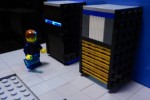It is amazing that something as simple-sounding as making an array get bigger can be so complex, yet scaling storage is notoriously difficult. Our storage protocols just weren’t designed with scaling in mind, and they lack the flexibility needed to dynamically address multiple nodes. So my hat is off to these companies and others who have come up with clever ways to maintain compatibility while scaling out beyond the bounds of a single storage array.
Features
Datacenter History: Through the Ages in Lego
Readers of my blog know that I love computer history. Therefore, I decided to focus my entry in Juniper Networks’ “Build the Best (Lego) Data Center” contest on the history of computing. Specifically, I would re-create key historic machines to contrast them with a modern view.
Sony QX100 Lens Camera: Ruined by a Flaky iOS App
I was thrilled by the possibilities of adding a professional-quality camera sensor and lens to my iPhone, so I immediately pre-ordered Sony’s DSC-QX100 “lens camera”. It held so much promise, not just as a real innovation but also as a major productivity tool. That’s why I’m angry to write this, a scathing review of the horrid software that ruins the QX10 and QX100 experience. Do not buy this device.
Microsoft’s Big Chance to Change
It takes a truly-remarkable leader to be willing to kill his old golden geese to make room for a new one; so far, only Apple and Amazon seem willing to forgo continuity in the name of profitable destruction. But new corporate leadership at Microsoft might un-stick the company and awaken the once-innovative Redmond powerhouse. The retirement of Steve Ballmer is welcome news.
Thinking About Storage In a New Way, From Cloud to Flash, with Dropbox and Fusion-io
I’ve been a storage revolutionary for quite a while, looking for new ways of data storage rather than technologies that perpetuate the same old approaches. That’s why I’m excited about the implications of two very different API access methods announced by Dropbox at DBX and by Fusion-io today at OSCON.




